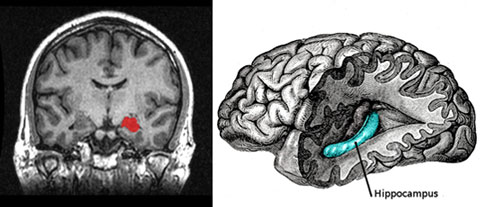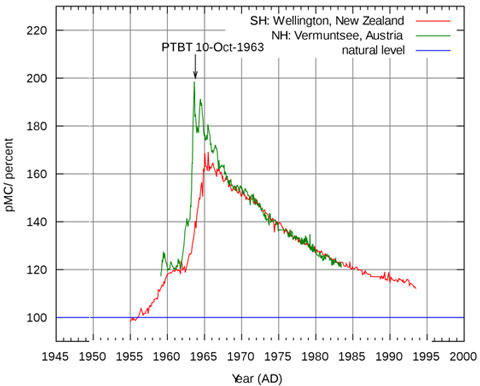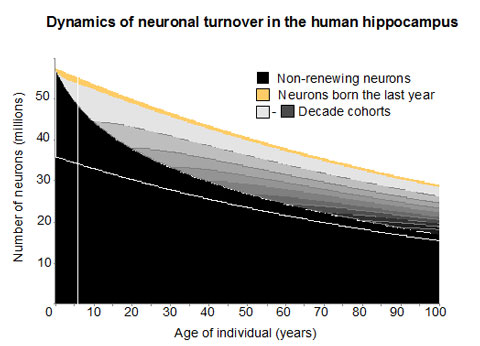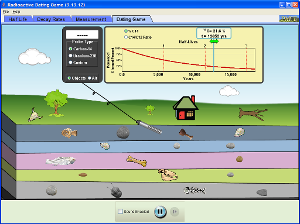Neurons and Nuclear Tests
July 2, 2013
Past nuclear blasts provide us with conclusive evidence that we get new neurons during our lifetime – about 1400 per day for adults!1 After more than a decade of trying to determine if humans produce new neurons, one Swedish research group has finally come up with a novel method using above ground nuclear testing data.
The Changing Times of Neurons
Neurons are cells that make up our brain and spinal cord allowing us to process our surroundings. They “fire” electric and chemical signals when the potential difference across their cell membrane reaches a critical voltage.
Unlike other body cells, neurons don’t undergo mitosis (cell splitting). Instead, neural stem cells can generate new specialized neurons by differentiating into neuroblasts that, upon migration to a specific area, can turn into a neuron. The neuroblasts can undergo mitosis.
Neural stem cells, like all stem cells, may sit around for long periods of time before they generate a neuroblast. In the 1960’s, scientists had the first indication that neurons might be generated in an adult rodent brain but it wasn’t until the 1990’s that scientists discovered the neural stem cells and the generation of neurons in the adult rodent brain. So it has long been wondered whether or not humans get new brain cells.
In the late 1990’s scientists studying neurogenesis, the creation of new neurons, were using a special chemical to mark the neurons. This marker (bromodeoxyuridine) attaches onto the DNA of splitting cells, like neuroblasts. Scientists injected the marker into live mice and, after their death, studied the mice to see if there were any new neurons formed in the brain. This marker successfully showed that the mice had created new neurons in the hippocampus (associated with memory and pattern formation) and the olfactory bulb (associated with the sense of smell).
Around the same time, scientists began studying neurogenesis in humans. The results of a study of five adult brains showed the creation of new neurons in a part of the hippocampus called the dentate gyrus. These studies ended quickly, however, because this particular marker was found to cause mutations.2 These new neurons were only seen to occur in the dentate gyrus portion of the hippocampus. The remainder of the hippocampus did not show generation of new neurons (neurogenesis).

Left: MRI image of brain with hippocampus in red. Image Credit: Amber Rieder and Jenna Traynor Right: A side view of the hippocampus
Image Credit: Amber Rieder/Jenna Traynor and Looie496, respectively.
Researchers began looking for other means of determining the age of neurons, prompting some to seek a connection between nuclear testing and neuron genesis.
Brains in the Atomic Age
Radioactive decay can already tell us the age of dinosaur fossils or mummies. So why not use this information to figure out how old neurons are?
Atoms are classified by the number of protons they have. Carbon, for instance always has 6 protons, and atoms with small numbers of protons (below 20) are typically found with about the same number of neutrons as protons; atoms with more or fewer neutrons are called isotopes. Consequently, carbon usually has 6 neutrons, and is known as Carbon 12 and written as 126C. The isotope Carbon 13 has 6 protons and 7 neutrons, 136C. Carbon 14 is an atom with 6 protons and 8 neutrons in its nucleus, 146C.
Carbon 12 makes up about 99% of all the carbon found on Earth, while carbon 13 composes about 1%. Carbon 14 is present only in trace amounts of one part in a trillion.
Carbon 14 is radioactive; it decays (turns into) nitrogen 14 through a process known as beta decay. In this process a neutron decays into a proton, an electron, and an anti-neutrino (an electron anti-neutrino).
146C → 147N+e-+ve
Carbon 14 has a half-life of about 5,730±40 years – the amount of time it takes for half of the original material to decay. Almost all of the carbon 14 on Earth is created when cosmic rays interact with nitrogen in the atmosphere, causing a nuclear process that turns nitrogen into carbon 14.
The amount of carbon 14 remains constant in our atmosphere, in our food supply, and in us – as long as we are living. All living organisms ingest carbon from the environment or breathe it in. Every living thing usually has about one part in a trillion of carbon 14.
Carbon Dating
This is why carbon dating is used to determine the age of how long ago something was alive. About every 5,730 years (give or take 40 years) after a living organism dies, the amount of carbon 14 within that organism decreases by half. Comparing the amount of carbon 14 to the total carbon you have allows scientists to approximate the age since something has died.
This might seem like finding a needle in a haystack, but it isn’t. Each DNA molecule in each human cell contains roughly 104.7 billion carbon atoms. This means for every 9.5 cells there should be one carbon 14 atom. Scientists measure the ratio of carbon 14 to the ratio of carbon 12, and figure out how many years have gone by, knowing what the ratio usually is.

The molecular structure of DNA.
Image Credit: Zephyris
The ratio of carbon 14 to carbon 12 is a good indicator of how long ago something had died for about 150,000 years after death, but the method doesn’t work so well for dinosaurs due to carbon 14’s short half-life.
Scientists estimate the age of dinosaur fossils with something that stays around longer like potassium 40, which has a half-life of about 1.26 billion years. Scientists also take into account the estimated dates of each sedimentary level. Uranium, for instance is often used to study the age of older rocks. The half-life of uranium 238 is about 4.468 billion years.
Try out the radioactive dating game using the embedded PhET simulator below!
Pulling it All Together
Keep in mind that this method does not usually work for living objects since they have the same one in a trillion ratio of carbon 14, and the researchers were trying to figure out a way to determine the age of neurons of a recently deceased human being to determine if any new neurons were formed during deceased person’s lifetime. This is where above ground nuclear testing plays a role.
Above ground tests proliferated between 1945 and 1963, producing a huge spike of carbon 14 which every living thing incorporated into any new cells created. The graph below shows the natural levels of carbon 14 in the atmosphere (blue line), the amount of carbon 14 in the southern hemisphere (red line), and in the northern hemisphere (green line) between 1945 and 2000.

Graph of carbon 14 levels in the atmosphere between 1945 and 2000. The blue line indicates naturally occurring levels, the red line represents levels in the southern hemisphere, and the green line indicates amounts in the northern hemisphere.
Image credit: Hokanomono.
This means that cells created during 1963 will have a higher ratio of carbon 14 than cells created before 1955 or after 1970. Consequently three key factors determine how many new neurons are produced in a lifetime: neurons do not undergo mitosis; neuroblasts do; and any new neurons that are generated will have a different ratio between carbon 14 and carbon 12.
The Results
The researchers behind the latest research at the Karolinska Institute in Stockholm collected neuron cells from the hippocampus and non-neuron cells from deceased individuals between 2000 and 2012, whose final ages ranged between 19 and 92 years. The usable set of samples consisted of 55 samples of neuronal cells and 65 samples of non-neuronal cells.
Researchers isolated the DNA and the carbon pulled out of them by various means including freeze-drying the cells, purifying the cells, and converting the DNA to graphite pellets (keeping only the carbon from the DNA). (See reference 1)
The cellular samples (in graphite form) were independently measured for carbon isotopes by two accelerator mass spectrometry laboratories. Because of the small sample size, special methods were developed and used as described in reference 5.
The researchers studied several mathematical models to determine the best fit and scenario for their data.
Their raw data showed four important points:1
- The amount of carbon 14 found in hippocampal neurons of the dentate gyrus was directly related to the amount of carbon 14 in the atmosphere after the birth of each individual donor, supporting the idea that new neurons are generated within the dentate gyrus after the original hippocampal neurons are formed.
- The oldest donors had higher levels of carbon 14 in their neuronal cells of the dentate gyrus than present in 1955, supporting the idea that new neurons were generated after 1955. Furthermore the oldest donor was 42 in 1955, which provides evidence that new neurons were created during the fifth decade of human life.
- Since the donors born at various times prior to the above ground nuclear testing had a relatively constant increase of carbon 14 concentrations, the rate that neurons are being produced in the dentate gyrus does not dramatically change with age.
- Those born before nuclear testing have lower levels of carbon 14 in the hippocampal neurons not located in the dentate gyrus, confirming that new neurons were created in the dentate gyrus, and not in other portions of the hippocampus.
Combining their raw results with the best mathematical model led them to the following results, shown below. These show a significant number of new neurons created in the dentate gyrus region of the hippocampus.

Illustration of the number of neurons in the hippocampus. Below the white line indicates neurons outside of the dentate gyrus region, above the white line indicates neurons in the dentate gyrus. The researchers describe the new neurons as a requirement for “efficient pattern separation and the ability to store and distinguish similar experiences as distinct memories,” and the old neurons as “necessary for pattern completion.”1
Image Credit: Frisén lab
Moving Forward
When asked what they will do next, lead researcher Jonas Frisén said, “We are most interested in studying whether hippocampal neurogenesis is affected in psychiatric disease, and mainly depression.”
The current research trend in neurogenesis of the hippocampus seems to be in trying to figure out the role of these new neurons, how they are used in memory formation, and what factors affect them. For example, there is evidence that aerobic exercise is good to stimulating the production of new neurons and stress is bad,6 and discussion on the function of the new neurons.7
References and Resources
1. Spalding, K. et al., Cell 153, 1219–1227, June 6, 2013http://www.cell.com/retrieve/pii/S0092867413005333
2. Kempermann, G., What the Bomb Said About Science, Science, 340 (6137): 1180-1181, 7 June 2013
http://www.sciencemag.org/content/340/6137/1180.summary?sid=3a8a9e57-daf7-4899-9fa3-ff59755611ab
3. Meier, C., Recording a breathprint, ETH Life international, 12 July 2006
http://news.sciencemag.org/sciencenow/2013/06/atomic-bombs-help-solve-brain-my.html?ref=em
4. PhET simulator Radioactive Dating Game
http://phet.colorado.edu/en/simulation/radioactive-dating-game
5. Salehpour, M., et al., (2013) Accelerator mass spectrometry of ultra-small samples with applications in the biosciences, Nucl. Instrum. Meth. B 294, 97-103
6. Déry N, Pilgrim M, Gibala M, Gillen J, Wojtowicz JM, MacQueen G and Becker S (2013) Adult hippocampal neurogenesis reduces memory interference in humans: opposing effects of aerobic exercise and depression. Front. Neurosci. 7:66. doi: 10.3389/fnins.2013.00066
http://www.frontiersin.org/Neurogenesis/10.3389/fnins.2013.00066/abstract
7. Epp JR, Chow C and Galea LAM (2013) Hippocampus-dependent learning influences hippocampal neurogenesis. Front. Neurosci. 7:57. doi: 10.3389/fnins.2013.00057
http://www.frontiersin.org/Neurogenesis/10.3389/fnins.2013.00057/abstract
—Heide Doss















